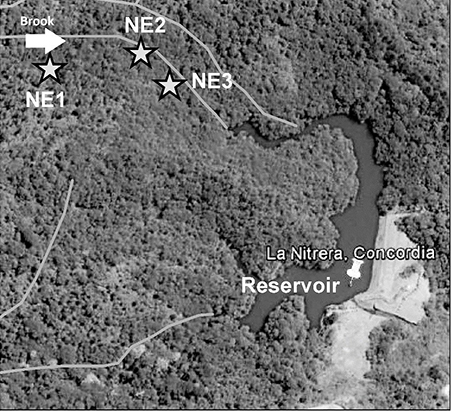Effect of the Ground Slope and Soil Infiltration on the Water Nitrate Ion Concentrations
Efecto de la Pendiente y de la Infiltración del Suelo en las Concentraciones de Iones de Nitrato en el Agua


This work is licensed under a Creative Commons Attribution-NonCommercial-NoDerivatives 4.0 International License.
Copyright statement
The authors exclusively assign to the Universidad EIA, with the power to assign to third parties, all the exploitation rights that derive from the works that are accepted for publication in the Revista EIA, as well as in any product derived from it and, in in particular, those of reproduction, distribution, public communication (including interactive making available) and transformation (including adaptation, modification and, where appropriate, translation), for all types of exploitation (by way of example and not limitation : in paper, electronic, online, computer or audiovisual format, as well as in any other format, even for promotional or advertising purposes and / or for the production of derivative products), for a worldwide territorial scope and for the entire duration of the rights provided for in the current published text of the Intellectual Property Law. This assignment will be made by the authors without the right to any type of remuneration or compensation.
Consequently, the author may not publish or disseminate the works that are selected for publication in the Revista EIA, neither totally nor partially, nor authorize their publication to third parties, without the prior express authorization, requested and granted in writing, from the Univeridad EIA.
Show authors biography
Soil characterization plays an essential role in the water flow and availability of nutrients. In accordance with the above, this research sought to find a relationship between the soil slope, soil particle grain size distribution, infiltration rate, and the nitrate ion movement through the soil profile and in the water table of the Quebrada La Nitrera, located in a Colombian tropical nature forest reserve. It was observed that the slope and the rate of infiltration explain the nitrate concentrations from one site to another. Additionally, in April 2018, where on average there is more precipitation for the study area, the highest groundwater nitrate ions concentration (18 mg / L) was reported according to the standard value for natural waters (10 mg / L). This suggests that hydrological events also influence the transport of these minerals.
Article visits 829 | PDF visits 390
Downloads
- Connolly, C. T. et al. (2018) ‘Watershed slope as a predictor of fluvial dissolved organic matter and nitrate concentrations across geographical space and catchment size in the Arctic’, Environmental Research Letters. doi: 10.1088/1748-9326/aae35d.
- Departamento Administrativo de Planeación (2009) Cátedra municipal. Edited by A. municipal Concordia.
- Donoso, C. (1994) Ecología forestal. 4ta Edició. Edited by E. Universitaria. Santiago, Chile.
- Duffková, R. et al. (2019) ‘Experimental evaluation of the potential of arbuscular mycorrhiza to modify nutrient leaching in three arable soils located on one slope’, Applied Soil Ecology. doi: 10.1016/j.apsoil.2019.06.001.
- González, L., González, A. and Mardones, A. (2003) ‘Evaluación de la vulnerabilidad natural del acuífero freático en la cuenca del río Laja, centro-sur de Chile’, Revista Geológica de Chile, 30(1), pp. 3–22.
- IGAC (2007) Estudio general de suelos y zonificación de tierras del departamento de Antioquia. Tomo I.
- Kasper, M. et al. (2019) ‘N2O emissions and NO3 2 leaching from two contrasting regions in Austria and influence of soil, crops and climate: a modelling approach’, Nutr Cycl Agroecosyst, 113, pp. 95–111. Available at: https://doi.org/10.1007/s10705-018-9965-z.
- Mejía, G. (1963) Conocimientos básicos de suelos. Universidad de Caldas, Manizales.
- Montenegro, H. and Malagón, D. (1990) Propiedades físicas de los suelos. Sección im.
- O’leary, M., Rehm, G. and Schmitt, M. (1989) Understanding Nitrogen in Soils. University of Minnesota.
- Ouedraogo, I., Defourny, P. and Vanclooster, M. (2019) ‘Application of random forest regression and comparison of its performance to multiple linear regression in modeling groundwater nitrate concentration at the African continent scale, Hydrogeology Journal. doi: 10.1007/s10040-018-1900-5.
- Pachecho, J. and Cabrera, A. (2003) ‘Fuentes principales de nitrógeno de nitratos en aguas subterráneas’, Ingeniería, 7(2), pp. 47–54.
- Ram Maharjan, G. et al. (2018) ‘Approaches to model the impact of tillage implements on soil physical and nutrient properties in different agro-ecosystem models’, Soil and Tillage Research, 180, pp. 210–221. Available at: https://doi.org/10.1016/j.still.2018.03.009.
- Razavi Dizaji, A. et al. (2020) ‘Assessing pollution risk in ardabil aquifer groundwater of iran with arsenic and nitrate using the SINTACS model’, Polish Journal of Environmental Studies. doi: 10.15244/pjoes/112903.
- Rebolledo, B. et al. (2016) ‘Assessment of groundwater vulnerability to nitrates from agricultural sources using a GIS-compatible logic multicriteria model’, Journal of Environmental Management. doi: 10.1016/j.jenvman.2016.01.041.
- Thiers, Ó. and Gerding, V. (2007) ‘Variabilidad topográfica y edáfica en bosques de Nothofagus betuloides (Mirb) Blume en el suroeste de Tierra del Fuego’, Revista Chilena de Historia Natural, 80(2), pp. 201–211.
- Vidon, P. G. and Hill, A. R. (2006) ‘A landscape-based approach to estimate riparian hydrological and nitrate removal functions’, Journal of the American Water Resources Association. doi: 10.1111/j.1752-1688.2006.tb04516.x.
- Xie, M. et al. (2019) ‘Nitrate subsurface transport and losses in response to its initial distributions in sloped soils: An experimental and modelling study’, Hydrological Processes, pp. 1–15.
- Yang, S. H. et al. (2020) ‘Variation of deep nitrate in a typical red soil Critical Zone: Effects of land use and slope position’, Agriculture, Ecosystems and Environment. doi: 10.1016/j.agee.2020.106966.
- Zhou, J. et al. (2016) ‘Significant accumulation of nitrate in Chinese semi-humid croplands’, Scientific Reports. Nature Publishing Group, 6(1), pp. 1–8. doi: 10.1038/srep25088.




